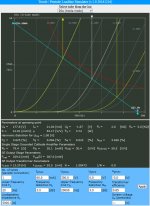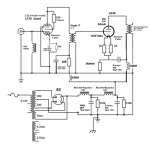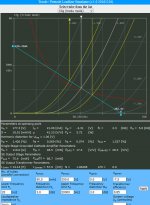My monoblocks are progressing nicely. Of course, I would like to advance the cause and tweak the schematic. As a baseline for the monoblock sounds, listening is non-fatiguing, taught bottom end (though not extended as I would like), smooth top end. Tonality is to my liking, natural and no extremes.
But, there is a slight bit of veil over the sound. Just the slightest opaqueness. So slight. So, I have a few ideas that may help remediate this issue. I am considering 3 alternatives, possibly all 3 eventually. Here are some ideas:
1. Replace the existing 100K grid resistor to a grid choke on the C3g.
2. Insert a new choke in front of the RC network feeding the IT / C3g.
3. Insert a new choke in front of the Russian 50uK Ultrapath cap which feeds the OPT.
All 3 of these option are highlighted with the blue boxes on the attached schematic.
I need your thoughts on these 3 options. Are these option expected to materially improve the monoblocks?
Thanks in advance.
View attachment C3g-45B 6.29.21 copy.pdf
But, there is a slight bit of veil over the sound. Just the slightest opaqueness. So slight. So, I have a few ideas that may help remediate this issue. I am considering 3 alternatives, possibly all 3 eventually. Here are some ideas:
1. Replace the existing 100K grid resistor to a grid choke on the C3g.
2. Insert a new choke in front of the RC network feeding the IT / C3g.
3. Insert a new choke in front of the Russian 50uK Ultrapath cap which feeds the OPT.
All 3 of these option are highlighted with the blue boxes on the attached schematic.
I need your thoughts on these 3 options. Are these option expected to materially improve the monoblocks?
Thanks in advance.
View attachment C3g-45B 6.29.21 copy.pdf
Last edited by a moderator:
IMHO all of them totally unnecessary.
1.) C3g hasn't any grid current, so grid choke is only wasting money, worth nothing.
2.) Without intermediate smoothing capacitor the 100H and serial 10k is meaningless solution.... BTW with this capacitor too. 😛pp
3.) The #45 "cathode loop" is closing via 50uF and last capacitor of PSU. If you interrupt it with choke, the cathode decoupling will be tilting.
1.) C3g hasn't any grid current, so grid choke is only wasting money, worth nothing.
2.) Without intermediate smoothing capacitor the 100H and serial 10k is meaningless solution.... BTW with this capacitor too. 😛pp
3.) The #45 "cathode loop" is closing via 50uF and last capacitor of PSU. If you interrupt it with choke, the cathode decoupling will be tilting.
"Simple" cathode decoupling is the cathode resistor bypassed by the capacitor.
In the case of ultrapath, the capacitor tied to the B+, where the last PSU capacitor act as "AC ground".
If you break it with the choke, the cathode decoupling only works trough series C-L-C, so cathode resistor bypassing with another frequency dependent equipment.
IMO if you want to use here choke forget the ultrapath layout.
p.s. In my opinion the 100H here (even with appropriate "new last capacitor") "slows down" the sounding.
In the case of ultrapath, the capacitor tied to the B+, where the last PSU capacitor act as "AC ground".
If you break it with the choke, the cathode decoupling only works trough series C-L-C, so cathode resistor bypassing with another frequency dependent equipment.
IMO if you want to use here choke forget the ultrapath layout.
p.s. In my opinion the 100H here (even with appropriate "new last capacitor") "slows down" the sounding.
Last edited:
Thanks euro21. So, I am out of ideas to help remedy the slight sonic veil that exists. If you don't mind, what would you do to this circuit to help transparency?
Just a few other random thoughts: 1) change the PS 50uF Russian PIO capacitors to DC Link caps. 2) adjust operating points. 3) go with a DHT driver tube
Thoughts?
Just a few other random thoughts: 1) change the PS 50uF Russian PIO capacitors to DC Link caps. 2) adjust operating points. 3) go with a DHT driver tube
Thoughts?
banpuku,
A slight sonic veil over what sound?
A Cello
A Soprano
A flute
A Jazz quartet
A Full orchestra
A Choral group
A Fully compressed and clipped rock band plus singers
Other?
What signal source?
Phono Cartridge
CD player
What specific recordings?
What are your speakers?
What is your room like?
Your amplifier should be very very good (I bet it is).
Have you tested the following:
Frequency Response into a load resistor
Harmonic Distortion into a load resistor
Intermodulation distortion into a load resistor
The Denon Audio Test CD has: spot frequencies; low freq/high freq IM test tones; dual high freq IM test tones; and an impulse that you can see the frequency response on a scope FFT (with a load resistor; and with the loudspeaker load because the rms of the impulse is low enough to not burn the speaker out, and to not hurt your ears).
You may not have a digital scope, but most of even the least expensive digital scopes have an FFT.
Be sure to pick a good listening day, when things are quiet, you are not tired, but not stressed either, and sit back and relax . . . relax. Do not concentrate on the sound of your system. Instead, listen to the music.
You may find that your system sounds much better than you thought it did.
Try and bring your speakers forward, perhaps no more than 2-1/2 feet away, turn the volume down, and enjoy near-field listening. Just to get you to hear something different.
Direct sound, and very little reflected sound.
Happy discoveries, and happy listening!
A slight sonic veil over what sound?
A Cello
A Soprano
A flute
A Jazz quartet
A Full orchestra
A Choral group
A Fully compressed and clipped rock band plus singers
Other?
What signal source?
Phono Cartridge
CD player
What specific recordings?
What are your speakers?
What is your room like?
Your amplifier should be very very good (I bet it is).
Have you tested the following:
Frequency Response into a load resistor
Harmonic Distortion into a load resistor
Intermodulation distortion into a load resistor
The Denon Audio Test CD has: spot frequencies; low freq/high freq IM test tones; dual high freq IM test tones; and an impulse that you can see the frequency response on a scope FFT (with a load resistor; and with the loudspeaker load because the rms of the impulse is low enough to not burn the speaker out, and to not hurt your ears).
You may not have a digital scope, but most of even the least expensive digital scopes have an FFT.
Be sure to pick a good listening day, when things are quiet, you are not tired, but not stressed either, and sit back and relax . . . relax. Do not concentrate on the sound of your system. Instead, listen to the music.
You may find that your system sounds much better than you thought it did.
Try and bring your speakers forward, perhaps no more than 2-1/2 feet away, turn the volume down, and enjoy near-field listening. Just to get you to hear something different.
Direct sound, and very little reflected sound.
Happy discoveries, and happy listening!
Oh, and at first glance, it appears that you are operating the EML 45B in 300B territory.
Perhaps a little too much stress for the EML 45B.
I do not think the addition of those chokes will help.
One more test, What do 1kHz and 10kHz square waves into an 8 Ohm power resistor, look like on a scope?
Perhaps a little too much stress for the EML 45B.
I do not think the addition of those chokes will help.
One more test, What do 1kHz and 10kHz square waves into an 8 Ohm power resistor, look like on a scope?
Last edited:
IMHO,
the decoupling capacitor (your Wima 30uF cap) of the interstage transformer
has a lot of influence on the SQ.
Try adding a small bypass cap like Audyn 0.1uF $.... or Mundorf S/G/O $$$$ ...
YMMV
the decoupling capacitor (your Wima 30uF cap) of the interstage transformer
has a lot of influence on the SQ.
Try adding a small bypass cap like Audyn 0.1uF $.... or Mundorf S/G/O $$$$ ...
YMMV
banpuku,
You may find that your system sounds much better than you thought it did.
6A3sUMMER - yes, my system does sound very good and I am happy. That said, like many others on this site, I am always seeking to find an improvement. Yes, I am nitpicking about the veiled sound, as it occurs on most, but not all, music. I listen 99% of the time to late 20th century and 21st century chamber music. Strings. Instrument solos have this very slight lifelessness and I am expecting/wanting more "life", bite, attack, transients. The tonality is perfect to my ears, but just want more jump. String staccato's should be alarming and make me pay attention. The lack of "jump factor" and slight opaqueness is on both my Gates CB500 analog and el-cheapo digital streaming sources. I am using EMIA phono stage and Elmaformer, very very nice products. Speakers are 8ohm, 90db Ilumnia Magisters which I found very pleasing, natural, non-fatiguing.
today, I will try some near field listening and report back.
As <fossa> wrote, Wima not the best choice for D3a cathode decoupling.
There are only 2.1V, so any -very- good electrolytic capacitor (for example Blackgate, Elna Cerafine or Silmic) better there than this Wima.
BTW I regularly use LEDs here.
There are only 2.1V, so any -very- good electrolytic capacitor (for example Blackgate, Elna Cerafine or Silmic) better there than this Wima.
BTW I regularly use LEDs here.
IMHO,
the decoupling capacitor (your Wima 30uF cap) of the interstage transformer
has a lot of influence on the SQ.
Try adding a small bypass cap like Audyn 0.1uF $.... or Mundorf S/G/O $$$$ ...
YMMV
Two updates.
1. I put a 0.47uF Jupiter Copper Foil Paper/Wax bypass on the WIMA cap leading into the IT. Yes, this opened up the sound and improved upon the transparency and a bit more attack/bite on the transients. Both welcomed improvements.
2. Separately from #1 above, a 0.47uF Jupiter Copper Foil Paper/Wax bypass on the WIMA cap on the Cathode Bias for the C3g driver. This appeared to have even more of an impact than #1 above. Note, I have not tried a bypass on both the IT and Cathode Bias caps.
So, what does this mean? To me, this implies that the caps indeed have a sonic signature. In my purist, simple mind, this is not good. Shouldn't we strive to have as little sonic signature as possible? I do. So, what can I do to eliminate these RC networks (cathode bias and B+ prior to IT)? Is there a way to use iron to eliminate the CAP sonic signature?
Thoughts?
1.) Are you sure, that your sketch in #1 post is correct?
180R in D3a cathode at 21mA produces 3.78V bias. At this bias the D3a is closed.
If you see my attachment the 177V, 21mA requires 79.4R cathode resistor (1.67V bias).
2.) Your IT hasn't correct secondary terminating. The transformed impedance at #D3a anode is indefinite, not 5k.
180R in D3a cathode at 21mA produces 3.78V bias. At this bias the D3a is closed.
If you see my attachment the 177V, 21mA requires 79.4R cathode resistor (1.67V bias).
2.) Your IT hasn't correct secondary terminating. The transformed impedance at #D3a anode is indefinite, not 5k.
Attachments
1.) Are you sure, that your sketch in #1 post is correct?
180R in D3a cathode at 21mA produces 3.78V bias. At this bias the D3a is closed.
If you see my attachment the 177V, 21mA requires 79.4R cathode resistor (1.67V bias).
2.) Your IT hasn't correct secondary terminating. The transformed impedance at #D3a anode is indefinite, not 5k.
euro21,
1) good catch. the C3g (not D3a) cathode R = 100, not 180 as listed. Thanks.
2) what do you mean "IT hasn't correct secondary termination"? How should it be terminated?
Updated schematic below
Thanks!
Attachments
The first thing I would do right away is replace all the cathode bypass caps with DC Link caps. This is on the basis of a shootout I did on my 2 stage 300b amp, switching the cathode bypasses to the 300b outputs with clip leads. I tested an electrolytic, two types of audio grade polypropylenes (ICW PW and Clarity Caps), a motor run polypropylene and a Vishay DC Link. All around 40uf. The DC Link caps were more detailed and transparent and had better timbre - all-round the best cap, no contest. I then tried Vishay versus Kemet DC Links. Vishay was slightly purer and thinner, Kemet more full bodied. You could try both and choose. There's also Oscon etc. I found 40uF adequate for my system. Kemet were cheaper. I bought them from RS in the UK.
I prefer plate chokes with Russian FT-2 teflon caps, the best being some big amorphous core ones from NP Acoustics in Vietnam. I've also used Lundahl LL1660 interstages just as plate chokes using the primary and I prefer that sound. Far be it from me to say anything about Dave Slagle's interstages - he's a wizard with transformers. But for the sake of completeness you could try his IT as just a plate choke with FT-2 caps. No idea what that would give you, purely an experiment.
DC Link caps upgraded my system wherever I used them, so I also replaced the last cap in the PSU chain with them and that sounded better too.
I prefer plate chokes with Russian FT-2 teflon caps, the best being some big amorphous core ones from NP Acoustics in Vietnam. I've also used Lundahl LL1660 interstages just as plate chokes using the primary and I prefer that sound. Far be it from me to say anything about Dave Slagle's interstages - he's a wizard with transformers. But for the sake of completeness you could try his IT as just a plate choke with FT-2 caps. No idea what that would give you, purely an experiment.
DC Link caps upgraded my system wherever I used them, so I also replaced the last cap in the PSU chain with them and that sounded better too.
C3g (not D3a)
I thought it was an erratum, because in this C3g operating point the 5k loadline would occurs -sooner or later- tube (grid) damaging.
Attachments
I prefer plate chokes with Russian FT-2 teflon caps, the best being some big amorphous core ones from NP Acoustics in Vietnam. I've also used Lundahl LL1660 interstages just as plate chokes using the primary and I prefer that sound. Far be it from me to say anything about Dave Slagle's interstages - he's a wizard with transformers. But for the sake of completeness you could try his IT as just a plate choke with FT-2 caps. No idea what that would give you, purely an experiment.
DC Link caps upgraded my system wherever I used them, so I also replaced the last cap in the PSU chain with them and that sounded better too.
Andy - all of my WIMA caps are DC LINK (red box caps). I am now bypassing them with Jupiter and Riken caps. The ultrapath cap is the large russian PIO 50uF bypassed with a Jupiter.
Regarding the plate chokes, where would you start? the C3g plate? I see on several of Thomas Mayers designs that he uses a choke in between the B+ and the Interstage Transformer. Also, he uses a choke between B+ and the ultrapath cap. Thoughts on this?
- Home
- Amplifiers
- Tubes / Valves
- Next steps: grid and supply chokes for C3g drives 45B


